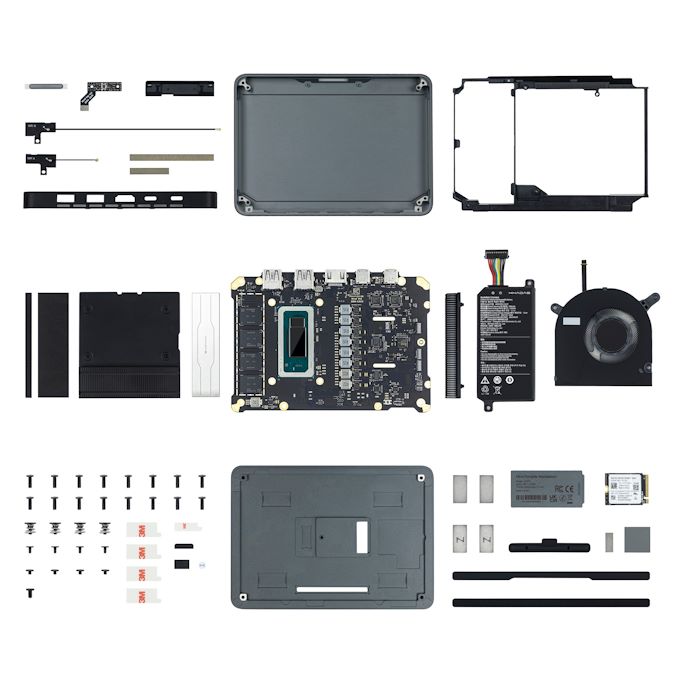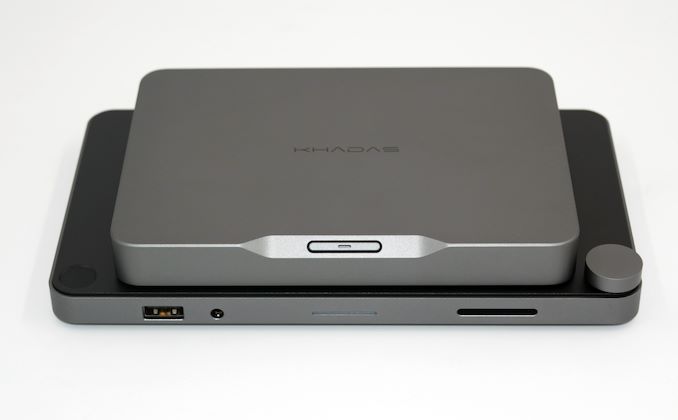The Khadas Mind ecosystem offers a compact and powerful portable workstation with a unique interface and modular peripherals, but lacks USB4/Thunderbolt 4 connectivity and limited I/O options.
- Innovative design with proprietary connector and interface for a more integrated and cohesive set of products
- Powerful performance with options for up to 32GB of RAM and a Gen4 NVMe SSD
- Modular approach to peripherals, allowing for easy customization and expansion
In recent years, the landscape of computing has been undergoing some fascinating transformations. With advancements in processor architecture and manufacturing technology, we’ve witnessed the rise of miniaturized computing systems, along with increasingly powerful and portable notebooks. But while these developments have certainly been impressive, they’ve also brought about their own set of limitations.
Enter Khadas, a well-known player in the ARM-based single-board computer scene, making waves with their innovative foray into the small form-factor x86 PC space. Their latest venture? The Khadas Mind ecosystem, a bold attempt to revolutionize the way we think about portable workstations.
At first glance, the Khadas Mind may seem like just another mini-PC. But dig a little deeper, and you’ll quickly realize that it’s anything but ordinary. Unlike traditional mini-PCs that rely on off-the-shelf components and standard interfaces, the Mind ecosystem is built around a proprietary connector and interface called the Mind Link. This unique approach allows for a more integrated and cohesive set of products, designed to work seamlessly together.
At the heart of the Mind ecosystem is the Khadas Mind Premium, powered by either an Intel Core i7-1360P or Core i5-1340P processor. With options for up to 32GB of LPDDR5 RAM and a blazing-fast Gen4 NVMe SSD, it’s no slouch when it comes to performance. But what really sets it apart is its ability to interface with a variety of peripherals via the Mind Link connector.
Take, for example, the Mind Dock. This handy accessory provides additional I/O expansion, including extra network ports, video outputs, and USB ports. It’s the perfect companion for users who need to connect multiple devices and peripherals to their workstation without cluttering up their desk.
Then there’s the Mind Graphics, an eGPU enclosure with support for the latest nVidia RTX GPUs. Whether you’re a gamer looking to boost your graphics performance or a creative professional in need of extra rendering power, the Mind Graphics has you covered.
But perhaps the most intriguing aspect of the Khadas Mind ecosystem is its focus on portability and modularity. The main unit itself is a sleek and compact slab, measuring just 146mm x 105mm x 20mm and weighing in at a mere 450g. With its metal enclosure and rounded edges, it exudes a sense of solidity and craftsmanship that’s often lacking in other mini-PCs.
Of course, no product is without its drawbacks. One notable omission from the Khadas Mind Premium is the lack of USB4/Thunderbolt 4 connectivity, which may disappoint users who rely on high-speed data transfer and external peripherals. Additionally, the relatively limited I/O options on the main unit may be a deal-breaker for some users who require more flexibility in their workstation setup.
Overall, the Khadas Mind ecosystem represents an exciting step forward in the world of portable computing. With its innovative design, powerful performance, and modular approach to peripherals, it’s poised to shake up the market and challenge the status quo. Whether you’re a tech enthusiast looking for the next big thing or a professional in need of a versatile and portable workstation, the Khadas Mind is definitely worth keeping an eye on.



About Our Team
Our team comprises industry insiders with extensive experience in computers, semiconductors, games, and consumer electronics. With decades of collective experience, we’re committed to delivering timely, accurate, and engaging news content to our readers.
Background Information
About ARM:
ARM, originally known as Acorn RISC Machine, is a British semiconductor and software design company that specializes in creating energy-efficient microprocessors, system-on-chip (SoC) designs, and related technologies. Founded in 1990, ARM has become a important player in the global semiconductor industry and is widely recognized for its contributions to mobile computing, embedded systems, and Internet of Things (IoT) devices. ARM's microprocessor designs are based on the Reduced Instruction Set Computing (RISC) architecture, which prioritizes simplicity and efficiency in instruction execution. This approach has enabled ARM to produce highly efficient and power-saving processors that are used in a vast array of devices, ranging from smartphones and tablets to IoT devices, smart TVs, and more. The company does not manufacture its own chips but licenses its processor designs and intellectual property to a wide range of manufacturers, including Qualcomm, Apple, Samsung, and NVIDIA, who then integrate ARM's technology into their own SoCs. This licensing model has contributed to ARM's widespread adoption and influence across various industries.

Latest Articles about ARM
About Intel:
Intel Corporation, a global technology leader, is for its semiconductor innovations that power computing and communication devices worldwide. As a pioneer in microprocessor technology, Intel has left an indelible mark on the evolution of computing with its processors that drive everything from PCs to data centers and beyond. With a history of advancements, Intel's relentless pursuit of innovation continues to shape the digital landscape, offering solutions that empower businesses and individuals to achieve new levels of productivity and connectivity.

Latest Articles about Intel
About Khadas:
Khadas is a well-known brand in the field of single-board computers (SBCs), gaining recognition for its commitment to innovation and quality since its establishment in 2014 by CEO Terry and co-founder Steven. Headquartered in Shenzhen, China, Khadas has established itself as a leading provider of high-performance SBCs catering to various applications, from do-it-yourself projects to professional ventures. With a strong emphasis on open-source development and community involvement, Khadas has built a loyal following among tech enthusiasts globally, cementing its reputation as a trusted source for state-of-the-art computing solutions.

Latest Articles about Khadas
About nVidia:
NVIDIA has firmly established itself as a leader in the realm of client computing, continuously pushing the boundaries of innovation in graphics and AI technologies. With a deep commitment to enhancing user experiences, NVIDIA's client computing business focuses on delivering solutions that power everything from gaming and creative workloads to enterprise applications. for its GeForce graphics cards, the company has redefined high-performance gaming, setting industry standards for realistic visuals, fluid frame rates, and immersive experiences. Complementing its gaming expertise, NVIDIA's Quadro and NVIDIA RTX graphics cards cater to professionals in design, content creation, and scientific fields, enabling real-time ray tracing and AI-driven workflows that elevate productivity and creativity to unprecedented heights. By seamlessly integrating graphics, AI, and software, NVIDIA continues to shape the landscape of client computing, fostering innovation and immersive interactions in a rapidly evolving digital world.

Latest Articles about nVidia
Technology Explained
eGPU: eGPU stands for external Graphics Processing Unit, and it is a device that allows users to connect a powerful graphics card to their laptop, desktop computer or handheld gaming console. This allows users to take advantage of the powerful graphics capabilities of the GPU without having to buy a new computer. This technology is especially useful for gamers, as it allows them to play games with higher graphical fidelity than their laptop or desktop computer would normally be able to handle. Additionally, eGPUs can be used to speed up video editing, 3D rendering, and other intensive tasks that require a lot of graphical power.
Latest Articles about eGPU
LPDDR5: LPDDR5 is a type of computer memory technology that is used in many modern computers. It stands for Low Power Double Data Rate 5 and is the latest version of the LPDDR memory standard. It is a type of dynamic random access memory (DRAM) that is designed to be more power efficient than its predecessors. It is used in many modern laptops, tablets, and smartphones to provide faster performance and longer battery life. LPDDR5 is also used in some high-end gaming PCs and workstations to provide faster loading times and smoother gaming experiences. It is also used in some servers and data centers to provide faster data processing and storage.
Latest Articles about LPDDR5
NVMe: Non-Volatile Memory Express (NVMe) is a newly developed technology that has been gaining traction in the computer industry. This technology is a standard interface which allows for high-speed storage and retrieval of data from solid state drives (SSDs). NVMe is designed to increase the speed of data transfers in storage systems by enabling a direct connection to PCI Express (PCIe) bus, resulting in significantly faster access times compared to traditional interface protocols such SSDs. NVMe is particularly useful for applications that require lightning-fast access to large amounts of high-value data. NVMe-based SSDs are being widely adopted in the computer industry and are being employed to power data centers, high-end workstations, and gaming machines to support lightning-fast data processing and retrieval, which unlocks possibilities for machine learning, real-time analytics, edge computing, and other cutting-edge applications. NVMe is proving to be an invaluable tool in the field of computing, offering immense
Latest Articles about NVMe
SSD: A Solid State Drive (SSD) is a modern data storage device that employs flash memory technology to store data electronically. Unlike traditional hard disk drives (HDDs), SSDs have no moving parts, resulting in significantly faster read and write speeds. This leads to quicker boot times, faster application loading, and smoother overall system performance. SSDs are known for their durability, shock resistance, and energy efficiency, making them ideal for laptops, ultrabooks, and other portable devices. They come in various form factors, including 2.5-inch, M.2, and PCIe cards, and are favored for their reliability, quiet operation, and reduced heat generation
Latest Articles about SSD
Thunderbolt 4: Thunderbolt 4 is a high-speed connection interface that enables data transfer between computers and peripherals. Thunderbolt 4 is the fastest version of Thunderbolt yet, with speeds up to 40 Gbps, and it is also the most versatile, with support for up to four 4K displays, dual 4K video, and up to 100W of power delivery. Thunderbolt 4 is ideal for connecting high-performance peripherals such as external storage drives, docks, and displays. It is also ideal for connecting multiple computers together for high-speed data transfer and collaboration.
Latest Articles about Thunderbolt 4
Trending Posts
TikTok’s Return to the US: A 12-Hour Blockade Launched
AAEON Launches BOXER-8654AI-KIT with NVIDIA Jetson Orin for AI Applications
MSI Offers $100 Steam Codes with Select Purchases, Boosting Gaming Incentives
China shows willingness to engage in dialogue to resolve TikTok issue in the US.
Samsung and Nexon Collaborate for a New Era in 3D Gaming with ‘The First Berserker: Khazan’
Evergreen Posts
NZXT about to launch the H6 Flow RGB, a HYTE Y60’ish Mid tower case
Intel’s CPU Roadmap: 15th Gen Arrow Lake Arriving Q4 2024, Panther Lake and Nova Lake Follow
HYTE teases the “HYTE Y70 Touch” case with large touch screen
NVIDIA’s Data-Center Roadmap Reveals GB200 and GX200 GPUs for 2024-2025
Intel introduces Impressive 15th Gen Core i7-15700K and Core i9-15900K: Release Date Imminent
